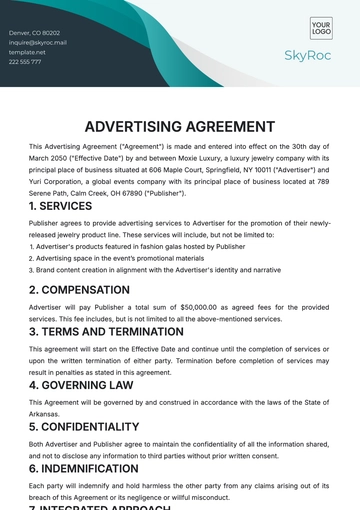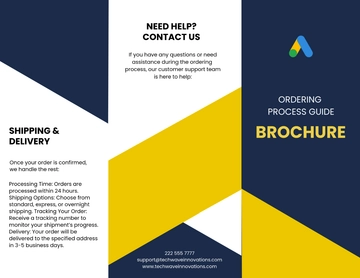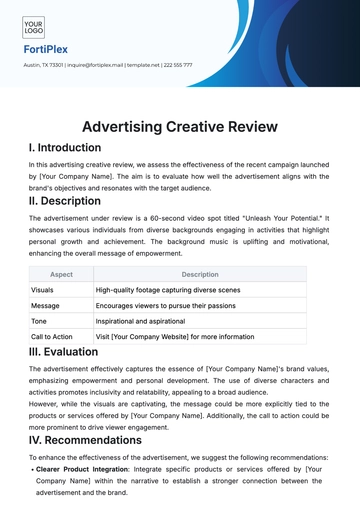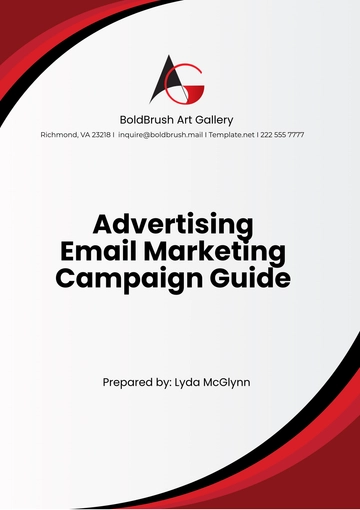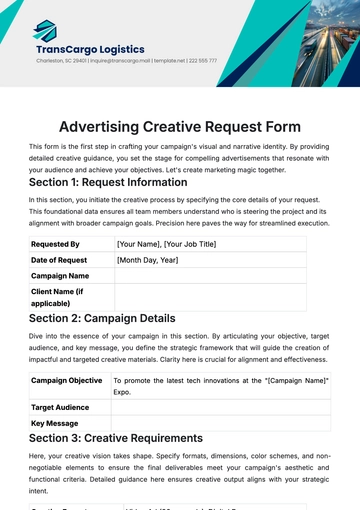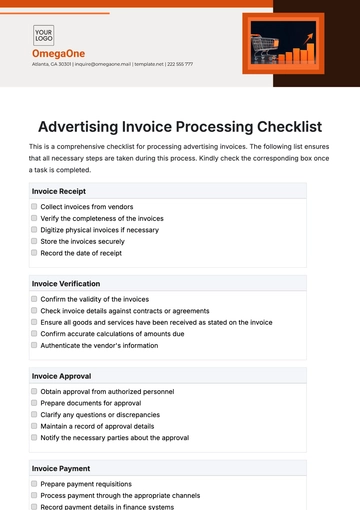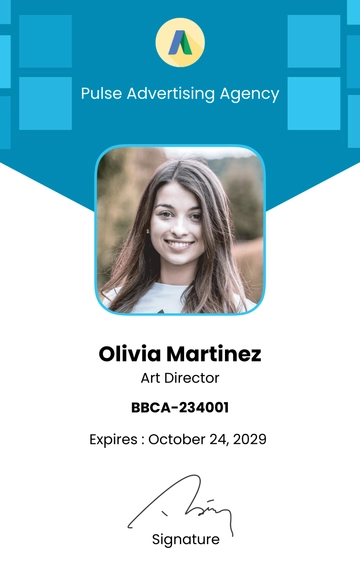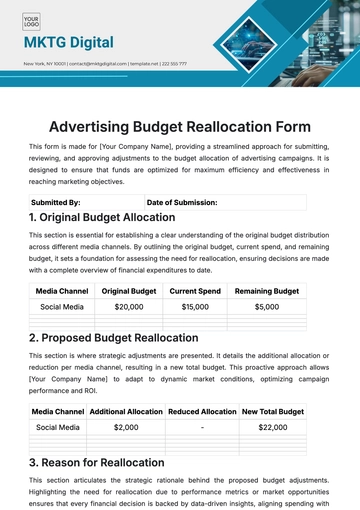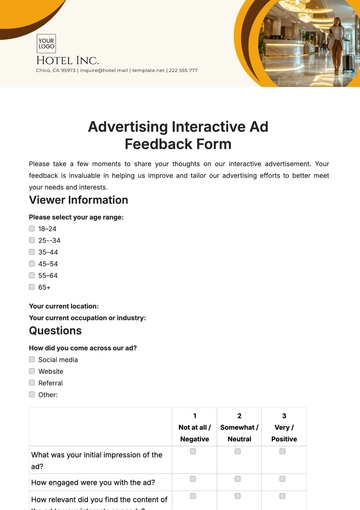Free Advertising Campaign Governance Framework
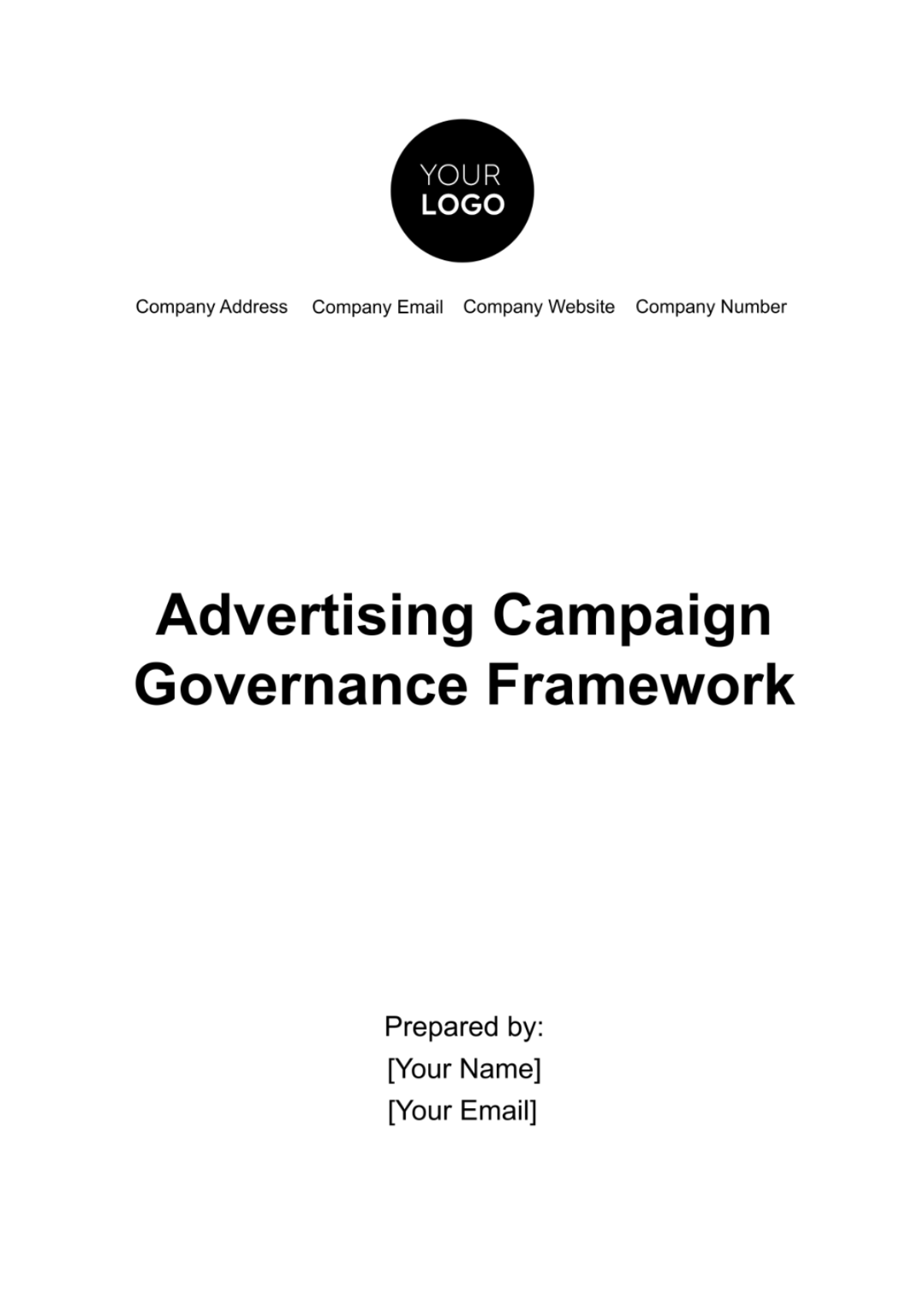
I. Introduction
We would like to extend a warm welcome to you as you explore the Advertising Campaign Governance Framework, which has been specifically tailored to suit the needs of [Your Company Name]. In this particular section, we aim to provide a comprehensive understanding of the purpose, scope, and the principal objectives of the governance framework.
This information is designed to assist you in grasively understanding how the framework operates and the significant role it can play in organizing your advertising campaigns effectively.
A. Purpose
The primary purpose of this Advertising Campaign Governance Framework is to establish a comprehensive set of guidelines and procedures that will govern the planning, execution, and optimization of advertising campaigns conducted by [Your Company Name]. By doing so, it ensures that advertising efforts align with the broader business objectives, achieve measurable outcomes, and adhere to industry standards and regulations.
B. Scope
The scope of this framework encompasses all aspects of advertising campaign management within [Your Company Name]. It applies to various advertising channels, including but not limited to digital, print, broadcast, and outdoor advertising. This framework also covers the entire lifecycle of advertising campaigns, from initial planning and budgeting to execution, monitoring, optimization, and reporting.
C. Key Objectives
The key objectives of implementing this framework are as follows:
Efficient Resource Utilization
Ensure that advertising resources, including budget, personnel, and creative assets, are allocated efficiently to maximize the return on investment (ROI) for each campaign.
Alignment with Business Goals
Establish a clear connection between advertising objectives and the overarching business goals of [Your Company Name]. Campaigns should contribute directly to achieving these goals.
Compliance and Accountability
Adhere to industry regulations and best practices while maintaining accountability for all advertising activities. This includes ethical advertising, data privacy, and transparency.
Continuous Improvement
Implement a culture of continuous improvement by regularly analyzing campaign performance data, optimizing strategies, and enhancing creative elements. This ensures that each campaign becomes more effective over time.
II. Governance Structure
Effective governance is essential for maintaining control, oversight, and accountability throughout the advertising campaign lifecycle. This section outlines the key components of the governance structure.
A. Roles and Responsibilities
Successful campaign management relies on clearly defined roles and responsibilities for all stakeholders involved. The following roles are critical to the governance structure:
Marketing Team
Define campaign objectives: The marketing team is responsible for setting clear and specific campaign objectives that align with the overall marketing and business strategy.
Allocate budget: They allocate the campaign budget, considering factors such as media spend, creative production, and technology expenses.
Approve creative assets: Ensure that all creative assets, including ad copy, visuals, and multimedia elements, align with the campaign strategy.
Monitor campaign performance: Continuously monitor key performance indicators (KPIs) and campaign progress to make data-driven decisions.
Partner Company
Collaborate on creative development: Work closely with the partner company to create compelling ad creatives that resonate with the target audience and align with the campaign's messaging.
Provide advertising insights: Share industry-specific insights, trends, and best practices to enhance the campaign's effectiveness.
Share campaign data and reports: Collaborate in data sharing and reporting to ensure transparency and facilitate data-driven decision-making.
Clients and Subscribers
Provide feedback and insights: Encourage clients and subscribers to provide feedback and insights on the advertising campaigns. This feedback is invaluable for improving targeting and messaging.
Participate in user-generated content campaigns: Engage clients and subscribers in user-generated content initiatives, leveraging their testimonials and content contributions.
Engage with the campaign: Encourage clients and subscribers to actively engage with the campaign, whether through social media interactions, purchases, or other desired actions.
B. Decision-Making Process
To ensure effective decision-making and streamlined communication, [Your Company Name] has established the following decision-making processes:
Weekly Status Meetings
Regular weekly status meetings will be conducted to discuss campaign progress, challenges, and opportunities. These meetings provide a forum for stakeholders to share updates, address issues, and align on campaign adjustments.
Quarterly Performance Reviews
Quarterly performance reviews allow for a comprehensive evaluation of campaign outcomes. During these reviews, the marketing team, partner company, and clients/subscribers assess campaign success against predetermined KPIs and objectives. This process informs strategic adjustments for upcoming campaigns.
Ad Hoc Decision-Making
In addition to scheduled meetings, ad hoc decision-making may be necessary to address urgent issues or seize time-sensitive opportunities. Stakeholders will remain agile and responsive to ensure campaigns remain on track.
III. Campaign Planning
Effective campaign planning is the cornerstone of a successful advertising initiative. This section delves deeper into the various aspects of campaign planning.
A. Objective Setting
Campaign-Specific Objectives
Define campaign-specific objectives that align with the overarching marketing and business goals. These objectives should be specific, measurable, achievable, relevant, and time-bound (SMART).
Consider objectives such as brand awareness, lead generation, customer acquisition, sales conversion, or product launch. Each objective should have clearly defined key performance indicators (KPIs) to track progress.
Alignment with Business Goals
Ensure that campaign objectives directly support broader business objectives. For example, if the business aims to increase revenue by [20%] in the next fiscal year, campaign objectives should contribute to this goal.
Regularly review and update campaign objectives to adapt to changing business priorities and market dynamics.
B. Budget Allocation
Budget Categories
Allocate the campaign budget strategically across different categories. Consider the following categories:
Media Spend: Determine the portion of the budget allocated to media buying, encompassing various advertising channels such as digital, print, TV, radio, and social media.
Creative Production: Set aside a budget for the development of ad creatives, including graphic design, copywriting, video production, and photography.
Ad Technology: Allocate resources for ad technology tools and platforms, including ad management systems, analytics tools, and automation software.
Ensure that budget allocation aligns with campaign objectives. For instance, if the primary objective is brand awareness, a larger portion of the budget may be allocated to media spend.
Contingency Planning
Establish a contingency budget to address unforeseen circumstances or opportunities that may arise during the campaign. This buffer can be critical for adjusting strategies in response to unexpected market shifts or competitive developments.
C. Target Audience
Buyer Personas
Create detailed buyer personas to understand the characteristics, preferences, and pain points of the target audience. These personas should encompass demographic, psychographic, and behavioral information.
Conduct market research and surveys to gather insights and refine personas continuously.
Audience Segmentation
Segment the target audience based on relevant criteria, such as demographics, geographic location, interests, and online behavior. This segmentation guides the selection of advertising channels and messaging.
Tailor messaging and creative assets to resonate with each audience segment.
D. Creative Strategy
Message and Value Proposition
Develop a clear and compelling message that communicates the campaign's value proposition to the target audience. The message should address the audience's pain points and highlight the benefits of the product or service. Ensure consistency in messaging across all campaign materials.
Creative Elements
Create engaging and visually appealing ad creatives, including images, videos, banners, and ad copy. These elements should capture the audience's attention and convey the campaign's message effectively. Perform A/B testing of different creative variations to identify the most effective designs and messaging.
IV. Execution and Monitoring
This section focuses on the execution of the advertising campaign and the continuous monitoring of its progress.
A. Media Buying
Channel Selection
Choose the most appropriate advertising channels based on the target audience and campaign objectives. Consider digital channels (e.g., social media, search engines), traditional media (e.g., TV, radio), and out-of-home (OOH) advertising.
Evaluate the reach, relevance, and cost-effectiveness of each channel.
Negotiations and Partnerships
Negotiate favorable terms with media vendors and publishers to maximize the value of the budget. Consider volume discounts, placement preferences, and added-value opportunities.
Explore strategic partnerships with media outlets to enhance campaign visibility and reach.
B. Ad Creative Deployment
Cross-Channel Consistency
Ensure that ad creatives are deployed consistently across all selected channels and platforms. Consistency in branding, messaging, and visuals reinforces brand recognition and trust.
Ad Scheduling
Plan ad scheduling to align with peak engagement times of the target audience. Consider time zones, device usage patterns, and historical performance data when scheduling ad placements.
C. Performance Tracking
Key Performance Indicators (KPIs)
Identify and monitor key performance indicators (KPIs) that align with campaign objectives. Common KPIs include click-through rate (CTR), conversion rate, return on ad spend (ROAS), and customer acquisition cost (CAC). Utilize analytics tools to collect and analyze real-time data on ad performance.
Real-Time Monitoring
Implement real-time monitoring of campaign performance to detect and address issues promptly. Monitor ad spend, impressions, clicks, and conversions to ensure that the campaign stays on track.
Data Integration
Integrate data from various advertising channels and platforms into a centralized analytics dashboard. This enables a holistic view of campaign performance and facilitates data-driven decision-making.
V. Optimization and Reporting
Optimization and reporting are crucial aspects of the advertising campaign governance framework. This section outlines the steps involved in optimizing campaign performance and generating informative reports.
A. Data Analysis
Data Collection
Implement robust data collection methods to gather data on campaign performance, audience behavior, and key metrics. Utilize tools such as Google Analytics, social media insights, and ad platform analytics. Ensure data accuracy and consistency by regularly auditing data sources and correcting discrepancies.
Performance Metrics
Continuously analyze performance metrics such as click-through rate (CTR), conversion rate, cost per acquisition (CPA), and return on investment (ROI). Compare these metrics against predefined KPIs to assess campaign effectiveness. Identify trends and patterns in the data to uncover actionable insights for optimization.
B. Continuous Improvement
A/B Testing
Conduct systematic A/B testing of ad creatives, messaging, and targeting parameters. Test different variations to determine which elements yield the best results.
Budget Reallocation
Adjust budget allocation based on the performance of individual channels and campaigns. Shift resources to channels that demonstrate the highest ROI and reallocate budget away from underperforming areas.
Campaign Iteration
Implement iterative improvements to campaigns based on data analysis and feedback. Refine audience targeting, messaging, and creative elements to enhance engagement and conversion rates.
VI. Conclusion
In conclusion, the Advertising Campaign Governance Framework provides a structured and comprehensive approach to managing and optimizing advertising campaigns for [Your Company Name]. This section summarizes the key takeaways and highlights the framework's significance.
A. Achieving Success
The framework aims to help [Your Company Name] achieve advertising objectives efficiently while maximizing the return on investment. It ensures that campaigns are aligned with business goals, compliant with industry regulations, and subject to continuous improvement.
B. Continuous Communication
Effective governance, including defined roles and responsibilities, fosters clear communication among stakeholders. Regular status meetings and performance reviews facilitate collaboration and decision-making.
C. Data-Driven Excellence
The framework emphasizes data analysis, optimization, and iterative improvement. By making data-driven decisions and continually refining strategies, [Your Company Name] can enhance campaign effectiveness and stay competitive.
D. Adaptive Approach
In a dynamic advertising landscape, adaptability is key. [Your Company Name] must be prepared to make ad hoc decisions, adjust budget allocations, and iterate campaigns to respond to changing market conditions.
E. Path to Growth
Through the diligent application of this framework, [Your Company Name] can not only achieve advertising success but also pave the way for sustainable growth and long-term success.
For any further questions or information, please do not hesitate to contact [Your Name] at [Your Company Email].
- 100% Customizable, free editor
- Access 1 Million+ Templates, photo’s & graphics
- Download or share as a template
- Click and replace photos, graphics, text, backgrounds
- Resize, crop, AI write & more
- Access advanced editor
Discover the ultimate Advertising Campaign Governance Framework Template on Template.net. Crafted for seamless planning and execution, this editable and customizable resource ensures strategic alignment, brand consistency, and regulatory compliance. Harness the power of our AI Editor Tool to streamline your advertising efforts and drive impactful results. Unlock your campaign's potential with precision and ease.

